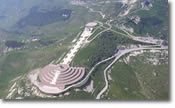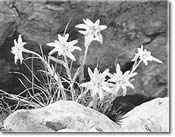
 |
FLORA AND FAUNA..... The geographic position of Monte Grappa and the entire southern zone of the mountain, facing the Veneto plain, makes for a very rich area in regards to flora and vegetation.
In fact, the climatic conditions derived from its positioning have favoured the integration of shrubby type vegetation, typical of mediterranean zones, with northern, mountain zone formations that occupy little space, so that we find forests principally of conifers and subalpine shrubs, just like zones frequently covered in snow.
In correspondence to the osprey cliffs of the lateral valleys, especially that of the river Brenta, plants capable of sustaining long periods of arid weather and significant temperature differences (arriving from eastern Europe and Siberia) have also found home on Grappa.
Of great interest is the Illyric species that have their largest distribution on the mountain; amongst these: the rare Centaurea rupestris of the karst environment, the Genista sericea, the Seseli gouanii, the Cytisus pseudoprocumbens and others.
The role that Monte Grappa plays as a refuge for rare species is shown with the presence of the Centaurea alpina, found in only two locations on the mountain: in the valley Cornosega and in the arid, rocky areas above Carpanè. The mountain is also at the limit of expansion for various species: the eastern limit for finding the Primula spectabilis, and the western limit for the diffusion of the Euphorbia kerneri and the Lilium carniolicum.
The grand floral richness of Monte Grappa is also derived from anthropication which, in prefering fields and pastures being mowed, resulted in large areas of forest being cleared in the lower altitudes (600-1200m asl) populated by ravine forests, creating favourable environments for the spreading of new, and even exotic, species.
Following the alteration of the natural environment, negative consequences have also resulted, such as the rapid spreading of new species and their dominance over vegetation native to the mountain. One significant example isthe false acacia that has infested many of the cleared or abandoned fields.
Native vegetation of the sub/lower mountain areas:
ravine forests: principally populated by aceri-tiglieti and in minor prevalence by maple ash-grove, sharing with species from the group of latifoglie nobili such as frassino maggiore, tigli, olmo montano, acero di monte, acero riccio and, in lower quantities, examples of black and white carpino.
Underbrush: prevelance of tasso, wide-leaved fusaggine and the rare Philadelphus coronarius;
Fields and pastures: variety of grasses, including the Lunaria rediviva, Phyllitis scolopendrium, ferns, aconiti, the Dentaria pentaphyllos, and the Asperula taurina.
Vegetation at the higher altitudes:
Forests: of pure or mixed beech with silver fir. In some parts, not effected by the presence of man, the underbrush is rich and well stratified. The north-west side displays a wide and articulated range of forest topology, with the significant distribution of forests and chestnuts.
|



